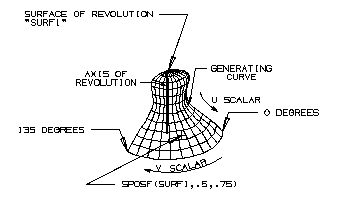
SPOSF(obj,u,v)
Returns the coordinates of a point on a surface at a position defined by the specified U and V parameters.
All Unigraphics surfaces are valid for SPARF and SPOSF.
|
Parameter |
Description |
|
obj |
A previously defined surface which is used to calculate the position from the specified U and V values. |
|
u,v |
Scalar values representing percentages of the surface in the respective direction, where 0 is the beginning of the surface and 1 is the end of the surface. A scalar value of .75 therefore, represents 3/4 of the surface and a scalar value of .5 specifies the midpoint of the surface in the respective direction of parameterization. The u and v scalar values are applied to the various surfaces depending on the order of the curves used to generate the surface and/or the type of surface used. For detailed information on the u and v directions, refer to the section on the development of the specific surface type. |
As with the CPOSF function, the desired point may lie on the surface or on an extension of the surface.
The U scalar pertains to the generating curve, and the V scalar pertains to the circular grid lines. For information on extensions in the U direction, refer to the specific object type in the CPOSF function discussed earlier. For the V direction, refer to arcs and ellipses under CPOSF.

Position on a Surface of Revolution
For the tabulated cylinder, the U scalar pertains to the generating curve, and the V scalar pertains to the directrix. Extensions off the surface are generated according to the type of curve in each direction. The generating curve may be any Unigraphics object, therefore, the extension my be calculated in several different ways. For information on extensions in the generating curve direction, refer to the specific object type in the CPOSF function.
Since the directrix must always be a line, extensions are always generated based on its length. For example, a scalar value of 1.25 would return the coordinates of a point on the line extension 1/4 of the line length past the endpoint of the line. Similarly, a scalar value of -.25 would return the coordinates of a point on the line extension 1/4 of the line length before the start point of the line. Therefore, obtaining the desired coordinates is dependent on knowing the direction in which the line was constructed.
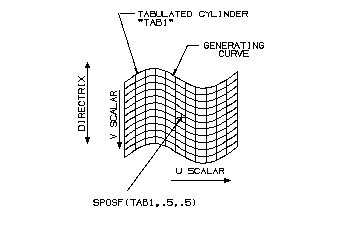
Position on a Tabulated Cylinder
The U scalar pertains to the two generating curves, and the V scalar pertains to the rulings. Since two curves are used to generate a ruled surface, the U scalar value is applied to both curves. The desired position lies on the surface, on a line connecting the two calculated positions based on the U scalar. The distance "up" the line is dependent on the V scalar. The V direction is dependent on the order in which the generating curves were selected. Zero lies at the first curve selected, and one lies on the second.
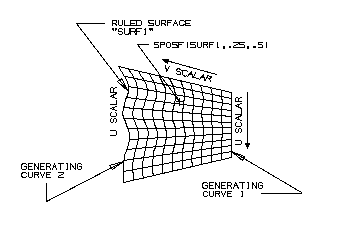
Position on a Ruled Surface
For the fillet surface, the U scalar pertains to the circular grid lines and its direction is from surface 1 to surface 2. The V scalar pertains to the two splines forming the edge curves of the fillet surface.
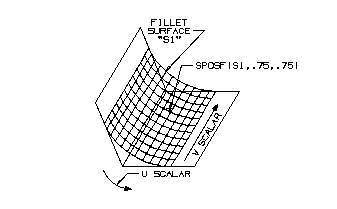
Position on a Fillet Surface
For the sculptured surface, the U scalar pertains to the primary curves,and the V scalar pertains to the cross curves. The directions of both U and V depend on the order in which the curves were selected. In addition, the extension of sculptured surface is developed in the same manner as the surface itself, which depends on such factors as order of selection, curvature, etc. Therefore, determining where the position on a surface extension lies may be only an approximation.
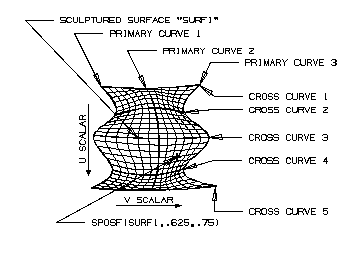
Position on a Sculptured Surface